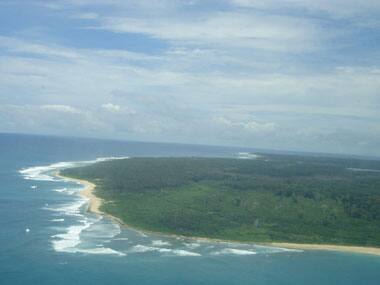The Nicobar Islands were on Thursday recognised as a World Biosphere Reserve by the United Nations Education, Scientific and Cultural Organisation (UNESCO). The recognition was granted at a UNESCO convention held in Paris on 30 May. With this addition, India now boasts of 9 sites that have been recognised by the United Nations organisation. The other eight are: Nilgiri (2000), Gulf of Mannar (2001), Sunderbans (2001), Nanda Devi (2004), Nokrek (2009) Pachmarhi (2009), Similipal (2009) and Achanakmar-Amarkantak (2012). [caption id=“attachment_830089” align=“alignleft” width=“380”]
 An aerial view of Nicobar Islands. Image: UNESCO/Zoological Survey of India[/caption] Biosphere reserves are sites established by countries and recognized under UNESCO’s Man and the Biosphere (MAB) Programme to promote sustainable development based on local community efforts and sound science. According to UNESCO, after a site is designated as a biosphere reserve, they remain under national sovereign jurisdiction, yet they share their experience and ideas nationally, regionally and internationally within the World Network of Biosphere Reserves (WNBR). The sites added at the 30 May convention are: Alakol (Kazakhstan) Great Nicobar (India) Marais Audomarois (France) Macizo de Cajas (Ecuador) Gochang (Republic of Korea) Snake Island (China) Mont Viso (France) Monviso (Italy) Mariñas Coruñesas e Terras do Mandeo (Spain) Terres de l’Ebre, Catalogne (Spain) Real Sitio de San Ildefonso-El Espinar (Spain)
For the complete world list, click here.
An aerial view of Nicobar Islands. Image: UNESCO/Zoological Survey of India[/caption] Biosphere reserves are sites established by countries and recognized under UNESCO’s Man and the Biosphere (MAB) Programme to promote sustainable development based on local community efforts and sound science. According to UNESCO, after a site is designated as a biosphere reserve, they remain under national sovereign jurisdiction, yet they share their experience and ideas nationally, regionally and internationally within the World Network of Biosphere Reserves (WNBR). The sites added at the 30 May convention are: Alakol (Kazakhstan) Great Nicobar (India) Marais Audomarois (France) Macizo de Cajas (Ecuador) Gochang (Republic of Korea) Snake Island (China) Mont Viso (France) Monviso (Italy) Mariñas Coruñesas e Terras do Mandeo (Spain) Terres de l’Ebre, Catalogne (Spain) Real Sitio de San Ildefonso-El Espinar (Spain)
For the complete world list, click here.
Great Nicobar Islands now part of World Biosphere Reserve
FP Staff
• May 31, 2013, 11:30:24 IST
The Nicobar Islands were on Thursday recognised as a world biosphere reserve by the United Nations Education, Scientific and Cultural Organisation (UNESCO).
Advertisement
)
End of Article